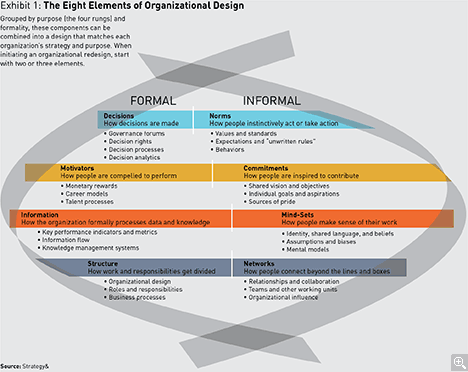The 10 Principles of Organizational DNA
Based on 10 years of organizational design (“organizational DNA”) research and 220,000 diagnostic surveys, here’s what we’ve learned about building high-performance companies. See also “Unlocking your organizational DNA.”
Anyone who’s celebrated a significant work anniversary knows just how a company can change over the years—who has a seat at the table, what customers expect, the most coveted skills. But there’s just as much that stays the same: what your brand stands for, the shared lexicon, your unique culture. We use the term organizational DNA as a metaphor for the underlying organizational and cultural design factors that define an organization’s personality and determine whether it is strong or weak in executing strategy. (See Exhibit 1.)
This year marks the 10th anniversary of our work on organizational DNA. Since our first article in 2004, we’ve analyzed more than 220,000 online surveys in which people describe their company’s personality and performance. Amid the turbulence of changing business environments and personnel, 10 precepts have remained useful, for empowering people and unlocking any organization’s potential.
1. There are only a few organizational personality types. Every company may seem unique, but in their enterprise-wide behavior, they fall into just seven behavioral patterns (in order from the least to most effective at execution): passive-aggressive, overmanaged, outgrown, fits-and-starts, just-in-time, military-precision, and resilient. People who take our online survey (the Org DNA Profiler®) continue to identify their company as one of these archetypes, regardless of industry and geography. That means that, no matter how pernicious a performance problem may seem, other companies have undoubtedly faced it before —and some have prevailed, often by changing their organizational personality.
No matter how pernicious a performance problem may seem, other companies have faced it before.
2. Companies are mosaics of personalities. Most companies contain a mix of personalities—having two or three, or more business units that fall under different archetypes. This is especially true of companies that have made major acquisitions. For example, a 20-year-old technology powerhouse might be a resilient organization. But its newly acquired health-tech division matches the fits-and-starts profile, characterized by smart entrepreneurial talent but a lack of collective discipline.
3. Weak execution is prevalent. The connection between the organization’s personality type and how well the organization executes on strategy is always strong. When we analyzed our most recent data set (more than 20,000 respondents), we discovered that a whopping 48 percent fit a profile distinguished by weak execution. And 11 percent fit into the most vexing of those profiles: the passive-aggressive organization, in which people pay lip service to results but consistently undermine the necessary efforts.
4. Strong execution is not self-sustaining. The 52 percent of respondents with a strong-execution archetype can’t afford to be complacent. In our experience, even a company with the most desirable profile, the resilient organization, must continually work to stay at the top of its game. For example, its leaders should relentlessly seek feedback from those closest to the market, encouraging and acting on criticism from customers and front-line employees, and taking action to address minor issues before they become bigger problems.
5. Performance is based on interdependent factors. Your organization’s DNA is made up of four pairs of building blocks: decision rights and norms, motivators and commitments, information and mind-sets, and structure and networks. The way that the building blocks combine determines your company’s aptitude for execution. It is crucial, then, for companies that want to improve their execution to consider the building blocks as a whole and not individually.
6. The org chart isn’t the solution. Many company leaders fall into a common trap: They think that changing their organization’s structure will solve their problems. They may remove significant management layers and temporarily reduce costs that way—but all too soon, the layers creep back in and the short-term efficiencies disappear. We see structure as the capstone, not the cornerstone. It’s better to change other formal elements first, like decision rights, motivators, and information flows, and then figure out the structural changes needed to support the revitalized company.
7. Intangibles matter. Those formal organizational DNA elements are attractive to companies because they’re tangible. They can be easily defined and measured. But they’re only half the story. Companies often realize this after they’ve made significant changes—reassigned decision rights, reworked the org chart, established new incentives, or set up knowledge-sharing systems—yet don’t see the results they expect. That’s because they ignored the informal, intangible elements. These include norms (what people think is the right way to behave), commitments (the promises people feel motivated to keep) mind-sets (deeply held attitudes and beliefs), and networks (connections among employees outside the formal structure). They add up to influence the ways people think, feel, communicate, and behave. Until you learn to influence these factors, your efforts to build performance will be unbalanced.
8. Decision rights and information flows deliver. Decision rights and information traits are twice as powerful as structure and motivators in driving organizational effectiveness. We analyzed dozens of strong-execution companies and discovered that information had the strongest correlation to execution, at 54 percent, and decision rights correlated at 50 percent. Structure came in at 25 percent. That may be why we see more and more companies making smart use of digital information technology to differentiate themselves. But these changes can also be low-tech. One company boosted its performance by setting up regular meetings to ensure that people at the top and the bottom of the hierarchy were regularly talking together, and information flowed more effectively among them.
9. Informal factors change when you focus on what works. The best approach for improving intangibles like norms and commitments is to use them as a force for transformation. So, instead of trying to change the culture of your company, use your intangible strengths to help improve it. Suppose your company is losing customers despite having a deep commitment to customer service. By focusing attention on a few powerful and positive behaviors, you can draw out that commitment and boost customer retention rates.
10. High performance can’t be isolated. Rarely do departments or business units work in isolation. Changes are more likely to last when they’re made holistically, across a company or division. Manufacturing needs to know what sales intends to sell, and sales, in turn, needs to know what marketing will promote. The more connectivity among different groups or functions, the more effective they can become.






